These four globular clusters are easy to find in autumn skies and a perfect way to welcome the season.
The crickets are tuning up for their autumn finale, and the light has changed, shining with a golden hue on a late crop of wildflowers. Tonight, we’ll track down a quartet of globular clusters that match the splendor of the meadows ablaze with a season’s farewell.
Gearing Up
Many people consider deep-sky observing the realm of “light buckets,” but patience and persistence go a long way with modest rigs. Big scopes certainly are useful for resolving these clusters to the core in a fiery multitude of stars, but I’ll be logging the observations with a 4-inch f/7 refractor and 10×50 binoculars. The best optic is the one you’re using.
M71: Sagittifolia (Arrowhead Flower)
Our first stop of the evening is the oft-overlooked M71, “nearby” at 13,000 light-years in the constellation of Sagitta, the Arrow. Not only is the cluster straightforward to find along the arrow’s shaft, but it also spotlights an unassuming constellation that’s easy to miss.
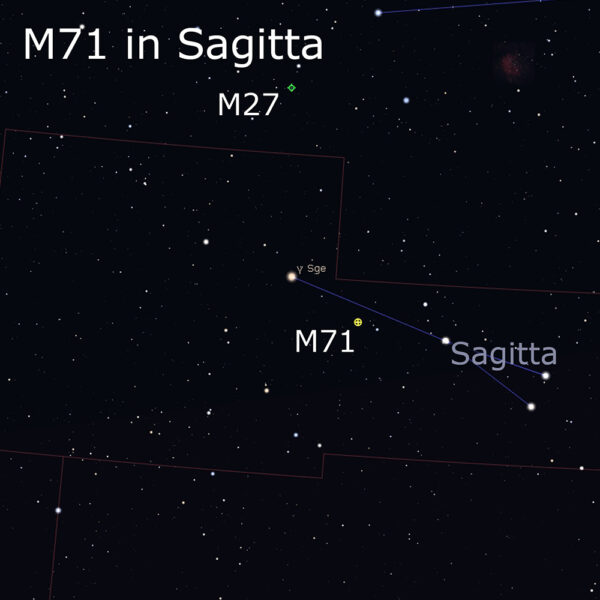
Stellarium, with additions by the author
The Milky Way starfield, which appears as a dew-spangled meadow, provides a breathtaking backdrop for this delightfully loose globular, one of the smallest of its class. Almost the density of a rich open cluster, the haze of stars teases my eye with hints of resolution in the refractor, yielding a sprinkling of individual members at 185×. However, my favorite views are at lower power. Decreasing power to 35× frames the stunning field and this “wildflower” in a most charming way. Don’t forget to visit the Dumbbell Nebula (M27) in nearby Vulpecula while you’re in the area.
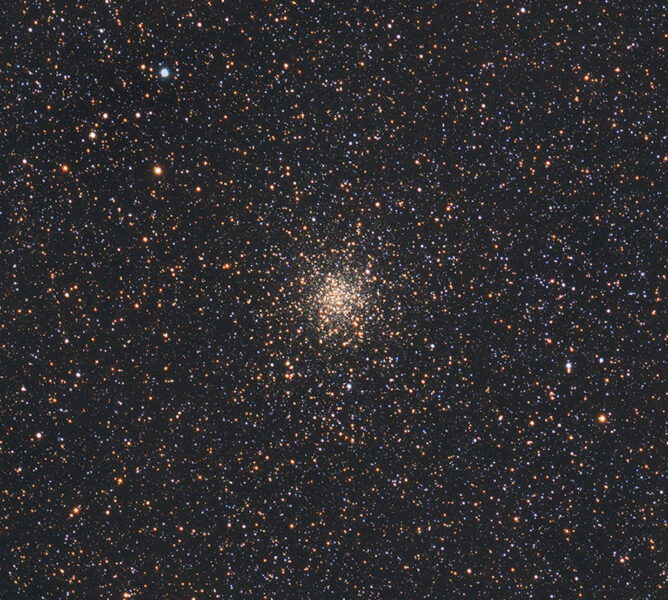
M15: Queen Anne’s Lace
M15 in Pegasus is next, displaying classic globular cluster magnificence. More than twice as far away as M71, these white umbrels sparkle at a distance of 33,600 light-years. Deeper observations have shown it hosts a rare intermediate-type nest of stellar-mass black holes at its center.
To find this autumnal favorite, I start at the bottom right corner of the Great Square of Pegasus (a star called Makab, the “shoulder” of the horse). I then follow the “muzzle” of the Winged Horse — Enif, or Epsilon (ε) Pegasi — and make a short jump to M15.
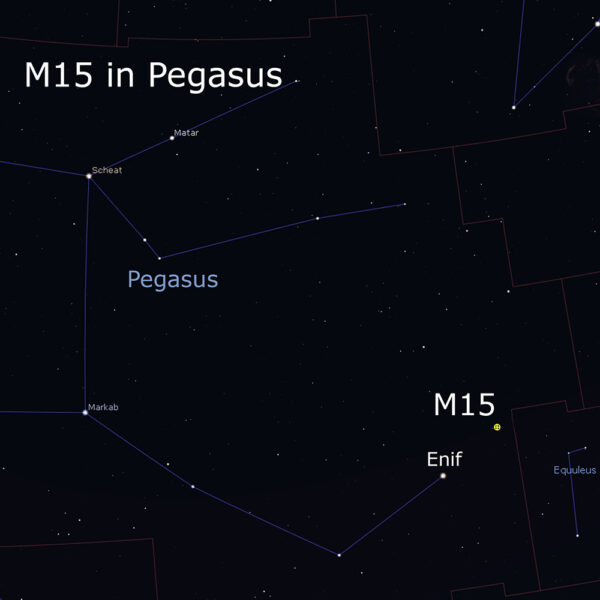
Stellarium, with additions by the author
One might imagine M15 as a heavenly wildflower that has interested the mythical horse. See if you can detect it with the naked eye. My 10×50 binoculars show a pleasing field, and telescopes increase the fun. A sharp core falls away into a glorious haze, a dynamic duo with a nearby 7.6-magnitude field star. This charismatic object displays a subtle yet energetic greenish tinge, giving it a distinctly cometlike appearance. It takes magnification well: 100× starts to pixelate it into hints of stars in the 4-inch refractor.
M2: Watercress by the Stream
M15 is a worthy (visual) sibling of our next target. Floating in a sparse tract of sky a third of the way from Sadalsuud, or Beta (β) Aquarii, in Aquarius to Enif in Pegasus, M2 is also easily spied in binoculars as a fuzzy star. Try to glimpse it with the unaided eye from a dark site, peering 55,000 light-years into space.
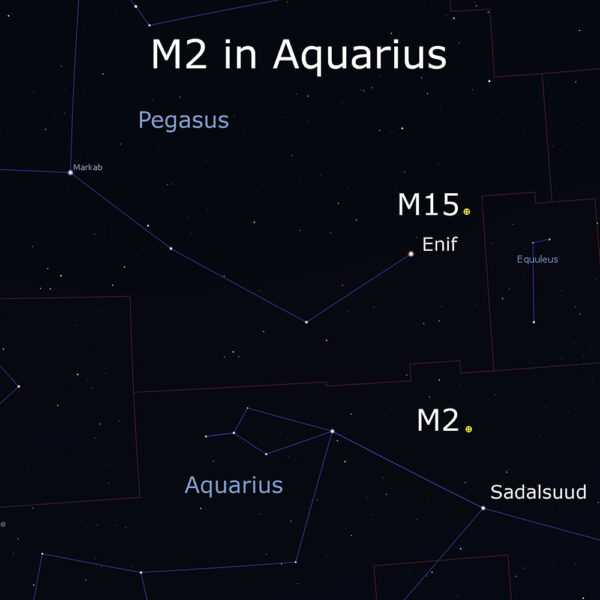
Stellarium, with additions by the author
A tranquil sight compared to the zing of M15’s busy corner of the meadow, M2 glows serenely in emptier space with the combined light of 150,000 Suns, and is, in contrast to M71, one of the largest of its kind. According to Burnham’s Celestial Handbook, the cluster’s brightest members are “red and yellow giants with absolute magnitudes of about –3.” Our own Sun at this distance would appear at magnitude 20.7! Increasing the magnification to 100×, I’m struck with the image of petals blowing away from the core of this ancient cluster.
M30: Seaflower of the Deep
Jupiter and Saturn blaze like lighthouses on our way to watery Capricornus, the Sea Goat. A binocular sweep eastward from Zeta (ζ) Capricorni reveals the tell-tale patch of something misty. M30 lurks 28,000 light-years away, westerly off the shore of 41 Cap, and low power shows a ghostly shimmer in the deep.
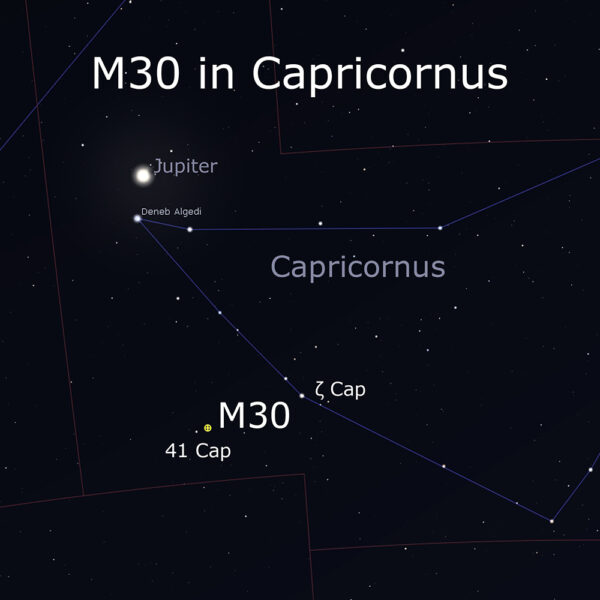
Stellarium, with additions by the author
An increase in magnification reveals something curious: a decided asymmetry. At 100×, the stars seem to trail off to one side, which might be why it's sometimes nicknamed the “Jellyfish Cluster.” Note the celestial “tentacles” floating along, as if to snare a tiny field star bobbing nearby.
Back on Earth
I hope you’ve enjoyed our botanical wander through the late-summer celestial meadow, viewing a dazzling variety within a single class of objects. Through careful observation, a patient astronomer can revel in the splendor and the subtlety of these wildflowers of the night. Clear skies!
Josh Urban observes the universe, day and night, from his house in Indian Head, Maryland.
 6
6









Comments
Robert-Hoeing
September 21, 2021 at 10:23 am
Very nice writing. Back in 2014 I did extensive gazing with a 15x70 I got for my birthday —- your article makes me want to resume; it’s been too long
You must be logged in to post a comment.
JUrban
September 22, 2021 at 6:12 pm
Thanks for the compliment, Robert! Oh yes, break out those 15's. These targets should look great in them. M71 should be especially stunning in that rig. The Milky Way starfield is not to be missed!
You must be logged in to post a comment.
Andrew James
September 22, 2021 at 9:13 pm
Q. Where do these common names come from? Whilst this adds to the charm of the article, you really need to state if this has been created by the author or is in common usage.
Also M71 Sagittifolia (Arrowhead Flower) is miss-named because the leaves are arrow-like not the flower, which has just three similarly sized petals.
The Jellyfish Cluster is shockingly confusing because the IC443 is the Jellyfish Nebula, planetary nebula NGC 6905 in Delphinus is sometimes 'Jellyfish Nebula', massive galaxy cluster called SDSS J1110+6459 is known as the Cosmic Jellyfish, a rare galaxy type called 'jellyfish galaxies.'
So who else calls M30 the 'Jellyfish Cluster'? I think you'll find it is a mistaken identity with IC 443 as recently as 2018, likely from the Denver Astronomical Society's Journal. I can find just 4-5 minor sources. I don't quite see how the general starfield relates to M30, as it is not intrinsic to M30 at all!
You must be logged in to post a comment.
JUrban
October 7, 2021 at 3:39 pm
Hey Andrew, these would be considered "nicknames." I'll be clearer in the future in regards to that. However, I did notice that Stellarium labels M30 as the Jellyfish Cluster as well. Let me know if you should come across an information on that in the future. Always interesting to hear where they come from!
You must be logged in to post a comment.
Dave Mitsky
October 2, 2021 at 6:06 pm
I just so happened to observe M2, M15, and M71 last night using Canon IS 15x50s from the Astronomical Society of Harrisburg's Naylor Observatory. M71, along with M56, was a rather tough target under the observatory's orange-zone skies.
On Tuesday night, I observed M30 using the Naylor Observatory's 17" f/15 classical Cassegrain. I then slewed a bit more than two degrees to the northeast to the small and faint globular cluster Palomar 12.
You must be logged in to post a comment.
JUrban
October 7, 2021 at 3:40 pm
Dave! A pleasure to see you here, sir. I'm an occasional poster on CN, and always appreciate your input. (I think we're both DC area stargazers, too.) Cool to hear you snagged these targets, especially with that 17". Would have loved to have seen that!
You must be logged in to post a comment.
You must be logged in to post a comment.